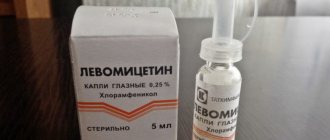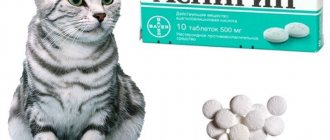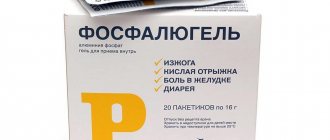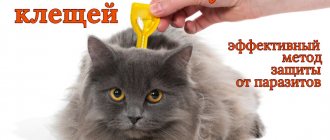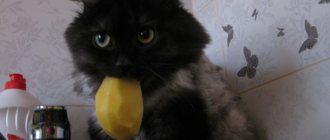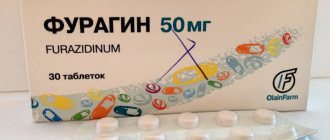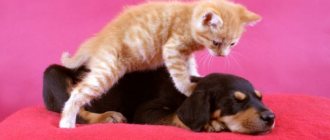6042Pavel
Glycine for cats is prescribed by veterinarians quite often, since the drug produced for humans is intended to improve metabolic processes and relieve emotional instability. Thus, to the question whether a cat can have Glycine, the answer is yes. The medicine is safe for animals, and due to the lack of bitterness in taste, there are no difficulties when administering it.
There are many indications for using the product. Often tablets are prescribed together with a herbal preparation - Kot-bayun drops and amino acid complexes. It is not prohibited to use Glycine when treating kittens. The dosage in this case is calculated individually for each animal.
© shutterstock
The components of the drug effectively penetrate biological fluids and are distributed throughout the cat’s body. Due to this, the composition easily enters the brain, restores its condition and establishes full-fledged functioning. The drug does not accumulate in tissues, which is important to prevent the development of intoxication in the cat’s body. Glycine is considered completely safe in veterinary practice.
how to give glycine to a cat
Glycine for newborns
Nowadays there is a lot of talk about how useful the drug Glycine is for newborns. However, not every young mother will risk giving her baby this or that medication without knowing everything she can about it. Let's talk about the features of this drug, its purpose and possible consequences of use.
The drug is able to have a complex, comprehensive effect on the baby’s body. Most often it is prescribed by neurologists, who highly value this remedy for reducing the child’s excitability, improving attentiveness and the ability to perceive information, normalizing the regime, and also improving metabolism in the brain. Moreover, experts can recommend this drug both for the treatment of certain brain disorders (consequences of fetal hypoxia, birth injuries, and so on) or neuroses, and for prevention purposes.
If you carefully read the reviews, you will learn about one very important advantage of Glycine: it can have a positive effect on the baby even with one-time use. That is, you do not have to undergo a whole course of treatment - improvement will come immediately.
Since the drug is available in tablets, you may seriously think about the question of how to give Glycine to newborns? You can’t just crush a tablet and pour the resulting powder into your child’s mouth! Fortunately, there is a very simple and accessible way out of the situation - while the baby is completely breastfed, his mother can take Glycine. Thus, the product will enter the body as part of mother's milk, and both mother and child will benefit from it.
If you have chosen this method to treat your baby with Glycine, then know that the required dosage of the substance can only be established by a specialist who is suitable for you.
Source
Preventing stroke in cats
- The cat needs to breathe fresh air. If she doesn’t go outside, let her breathe on the balcony or window.
- Keep your diet balanced.
- Avoid obesity in neutered cats.
- Never feed your cat stale food.
- Prevent murka's access to house plants - many are poisonous to them.
- Remove potentially toxic substances away (household chemicals, insect poison).
- Protect your little animal from stress.
- Give vitamins and anthelmintics regularly.
- Have active games every day.
Glycine tablets can be given to children
Glycine for children
Often, at an appointment with a pediatrician or neurologist, new mothers complain of restless behavior, poor sleep and the whims of the baby. And a specialist often prescribes a drug such as glycine. Your child may also have been prescribed this medicine. It is understandable that you, as a responsible parent, are concerned about whether glycine can be given to children and whether there will be harmful consequences from taking it. Let's try to dispel your doubts.
In general, glycine is an amino acid that has the property of protecting cells from nervous stimulation. This occurs due to the saturation of cells with oxygen and partial blocking of the effects of neurotransmitters on them. This is the name given to substances that transmit nerve impulses from cell to cell. Thus, the drug protects the child from anxiety and anxiety at the cellular level.
When taken, this amino acid quickly enters the blood, where it breaks down into carbon dioxide and water. This means that glycine does not accumulate in the body, which allows the drug to be prescribed to children, including infants and even newborns.
Glycine is available in tablet form. The form of its administration is resorption under the tongue. It is clear that when prescribing glycine to children, the dosage depends on age, as well as on the diagnosis. Thus, mentally healthy children are usually prescribed 1 tablet in a dosage of 0.1 g 3 times a day to improve memory and brain performance, with deviant behavior and psycho-emotional stress. The course of taking the medication according to this regimen should not exceed 2-4 weeks.
Glycine is prescribed to a one-year-old child in case of increased excitability. It goes without saying that such a baby will not be able to put the medicine under the tongue and dissolve it. Therefore, half the tablet is divided into 2-3 doses per day, crushed into powder and dissolved in a small amount of water. D
Signs of the disease
Lethargy is one of the signs of the disease.
If you watch your dog carefully, even the early stages will be obvious.
- The animal becomes lethargic and inactive. When walking, you can notice unsteadiness, the dog seems to be skidding. Sometimes the dog begins to walk sideways, wag its backside, walk with sagging and stretching of the whole body. Frequent lying, curled up, with the inability to unfold, is also characteristic of the onset of the development of this disease.
- The behavior and habits of the animal change; the dog can become either aggressive or overly apathetic. Refusing to follow commands and performing commands incorrectly is also a typical sign of brain damage.
- You can observe stiffness in the muscles of the back of the head; the dog will be reluctant to lift and turn its head, or even be afraid to move.
- Sometimes the urge to vomit appears, and the animal refuses to eat food and drink water.
- If you examine a dog's eyes, you can notice hemorrhages in the conjunctiva of the eye.
how to give glycine to a cat
Calming drugs for dogs
I'm wondering if anyone has given their pets sedatives, what kind and what was their effect? I gave the dog up for foster care, behaved normally for three days, and then began to destroy the enclosure, howled, became hoarse and broke his face. I gave it to a person he knows and treats well. We decided it was necessary to give him a sedative, I rarely leave him, he’s not used to it. So I wonder, who thinks what?
A dog left in foster care always experiences severe stress. Of course, there are sedatives and they are quite effective.
In modern pharmacology, there are many such drugs. Trying everything is simply unrealistic. Therefore, I will recommend those that I use myself and recommend to patients.
The drug glycine is sold in a human pharmacy. One of the essential amino acids. The principle of action is to stabilize the functioning of the nervous system.
It is better to start taking the drug a week before the upcoming foster care, the first exhibition, New Year's fireworks and similar predicted stressful situations.
Dosage. Glycine is prescribed to small dogs in the amount of one to two tablets, to medium dogs weighing up to forty kilograms - three to four tablets, to large dogs weighing more than forty kilograms - five tablets at a time. The drug should be given three times a day.
An effective anti-stress agent is ascorbic acid. This is a method for those who know how to give injections. A 5% solution for injection is used. Suitable both in situations where the dog is already in a state of stress, and to prevent it.
The solution is administered intramuscularly to large dogs, one ampoule (1 ml), and to medium-sized dogs, half an ampoule (0.5 ml). Once a day. Within five days before the predicted stress and two days after. No more than seven days!
If you have a cat or female cat, you may have
Source
Can a dog have Glycine?
Glycine can be used as a sedative for a dog, because it is a non-essential amino acid - harmless, suitable for use by any breed of animal. This drug is not available separately for veterinary practice, so you can use regular tablets from a pharmacy for humans.
Indications
Indications for a course of Glycine in dogs are:
- previous traumatic brain injury;
- cerebrovascular accident;
- previous stroke;
- impaired concentration, memory problems due to age-related changes in the pet.
Veterinarians recommend giving tablets to dogs that are in foster care - this increases their resistance to stress, pets more easily adapt to new conditions, and react adequately to people who are nearby.
Can I give it to calm me down?
Glycine is intended to calm and stabilize the nervous system, so they are given to dogs on the eve of:
- New Year's holidays - fireworks, salutes make the pet nervous, contribute to the development of phobias (fears);
- exhibitions - the dog should be as restrained as possible at this event and focused only on its owner;
- traveling by train or flying by plane - the road will be transferred calmly.
Contraindications
Glycine has no contraindications for dogs, but these tablets can cause an allergy attack. Therefore, allergic pets should be monitored, and owners should first consult with a veterinarian regarding the safety of such a therapeutic course.
can you give your cat glycine?
Sedative for cats: at home, preparations
Not every cat copes with stressful situations equally easily. For example, when an animal needs to be taken to the veterinarian, or to the country, or even to an exhibition. As a result of the move, the cat may become frightened and stressed, after which it will not be itself for several days. Obviously, to help the animal in this case, sedatives for cats are needed during transportation . Therefore, let’s look at what they are, what is worth using, and what is very undesirable.
There are two products that can be present in the house and act as a sedative on cats. However, the real result of their influence differs from that which can be seen in the behavior of the animal after their application. Let's find out why this is so.
If valerian acts as a sedative on a person, then for a cat it is a real drug. The fact is that the active substance of medicinal valerian (medical name for valerian) is similar to the pheromones of a cat during estrus. Because of this, it acts more like Viagra on cats, and even more so on cats, rather than as a sedative. In addition, already from the first time the cat begins to become addicted and dependent on valerian. The conclusion is simple - cats should never be given valerian!
You will often hear that catnip is a good sedative for cats. But in reality this is not the case, because it acts on the animal in exactly the same way as valerian, only several times weaker. That is, in essence, catnip does not act as a sedative on the cat, but only changes its behavior. In addition, if some animals love mint and rub quite near it, then it may not affect others (even in the form of a scattering of dried mint and in the form of a spray).
What sedative can
Source
Prevention
Prevention of stroke in a pet comes down to organizing living conditions. Proper nutrition, normal physical activity, timely vaccinations and treatment of chronic diseases can help avoid pathological conditions in the cat in the future.
A cat recovers after a stroke over a long period of time, and may not recover from its deplorable condition at all. Therefore, to prevent a stroke in a cat, it is necessary to reduce the amount of fat in the diet, replacing them with vitamin and mineral complexes.
It is imperative to carry out preventive treatments for your pet against parasitic infestations. It is advisable to regularly show older cats to a veterinarian, monitoring body functions, and especially monitoring blood pressure.
can glycine be given to a cat?
How to help a cat in heat
Many people, when getting cats, think little about what problems and some discomfort they may encounter. Most owners attribute this discomfort to the period of sexual arousal or estrus in cats. It is during estrus that cats meow loudly, try to jump out into the street, can mark their territory, and so on. A completely logical question arises: “How to help a cat during heat?”
The simplest and most basic thing you can do for your pet is to give as much attention and affection as possible. Statements that it is better not to touch cats during sexual activity are not entirely correct. On the contrary, show more tenderness and care, pick up, talk to, stroke and comb the cat more often. These simple manipulations will relieve tension and calm the animal a little.
Keep in mind that active games with your pet will also help to distract her at least a little from the irresistible desire to procreate. During heat, give your cat a good run so that she can throw out the accumulated energy.
First aid for stroke
Her life depends on how quickly the owner of a sick cat reacts. Of course, you shouldn't try to feed your cat human pills.
Just like people, injured cats need first aid.
There are a number of measures that can be taken before consulting a specialist:
- call a veterinarian by talking over the phone about the symptoms;
- lay the pet on its side (in a soft and safe place);
- try to open the cat’s mouth, check if the tongue is stuck (if saliva or vomit has accumulated in the mouth, you need to remove it with a clean napkin);
- if the cat does not lie down, but tries to walk, then you need to remove all objects that could injure it;
- remove all irritants (for example, if the cat is scared by the loud sound of the TV, it needs to be turned off).
This is where the owner's options end. The fact is that veterinary medicine is different from human medicine, so there is a risk of harming the cat. After all, you first need a specialist to confirm the diagnosis, but this cannot be done based on visible symptoms alone. While the veterinarian is driving, you can write down everything you remember about the signs of the disease. If you are going to take your pet to the clinic, then do not forget all the cat documents you have (certificates, veterinary passport, medical history, etc.).
After examination by a veterinarian, the clinic’s specialists will try to eliminate painful symptoms. Sometimes an injured cat needs an oxygen mask (this can provide additional oxygen to the brain). Cats with strokes are often given IVs with saline (to prevent dehydration); in some cases, a catheter may be required. After this, the veterinarian will select a further treatment plan.
Some veterinary clinics have special oxygen chambers for animals, they help supply the affected brain with oxygen
how to give glycine to a cat
Place the cat on the floor, squeeze him/her between your legs, or sit him/her on your lap.
Or just ask someone to hold the cat.
Your cat may react differently to different natural sedatives. If your pet doesn't respond to a medication the way you expected, try something else until you find what works for you. Such medications will not harm your animal, so they can be changed as often as you like.
You can also calm your cat using non-traditional remedies such as aromatherapy with lavender or citrus oils. Pheromones can also calm a cat by affecting his/her senses and making the animal feel safe.
Never give your cat human medications unless your veterinarian recommends it. Otherwise, you may worsen the cat's condition or provoke his/her illness. Moreover, the animal may die due to physiologically foreign chemicals entering the body.
Please keep in mind that the tips above are not intended to calm a feral cat you've trapped in a cage. These cats need to be sedated before surgery or before examination.
Sedative for cats: at home, preparations
Constipation may not be expressed
Not every cat copes with stressful situations equally easily. For example, when an animal needs to be taken to the veterinarian, or to the country, or even to an exhibition. As a result of the move, the cat may become frightened and stressed, after which it will not be itself for several days. Obviously, to help the animal in this case, sedatives for cats are needed during transportation . Therefore, let’s look at what they are, what is worth using, and what is very undesirable.
Source
Treatment and prevention of urolithiasis in cats and dogs
One of the aspects of pharmacological therapy for urolithiasis is the removal of uroliths, creating conditions leading to their dissolution. Such treatment is required much more often and more important than surgical removal of stones. In addition, drug therapy is always indicated to prevent recurrence of urolithiasis, either after surgical removal of stones or after their pharmacological dissolution. Drug therapy is also indicated to control stone-related urinary tract infections.
Pharmacological dissolution of stones
Dissolution is based on the principle of undersaturation of urine with the mineral components of the crystals that we plan to dissolve. In other words, the urine should be undersaturated with the chemical components that make up the stone, which will lead to the opposite tendency - the transition of crystals from the solid substance of sand (or stone) into urine. And vice versa, the more concentrated the urine, the faster the calculus will form. Thus, using certain drugs, we must change the chemical composition of urine. In order for the stone to dissolve, it must be constantly immersed in this less concentrated urine, so the ideal place for dissolution would be the bladder. Kidney stones can also be dissolved if organ function is adequate in the affected kidney, but kidney stones take longer to dissolve. Stones located in the ureter or urethra cannot be dissolved unless they are moved into the bladder naturally or by medical intervention. It takes 2 to 4 months for stones to dissolve in the bladder. If stones are found in the urethra in male dogs, if possible they should be moved back into the bladder so that they can be treated, but in such cases there is a risk of re-displacement into the urethra before it decreases or disappears. There are developed methods for dissolving sand and stones of struvite origin in dogs and cats, as well as for resolving urate and cystine stones in dogs, but there are no such effective methods for calcium-containing stones. The therapy required for dissolution depends on the type of urinary stone. Thus, it is very important to know the type of stone based on urinalysis along with clinical data.
Treatment cannot be carried out at random, assuming one reason or another. If the treatment decision is based on a guess, the calculus will not dissolve as expected, since the guess may be incorrect or the stone may contain more than one type of urolith. Surgical removal of the stone is indicated if the stone does not dissolve after 2 months of drug therapy or if it causes acute pain, bleeding, or blockage of the urethra or ureter.
Animals treated in this way should be examined regularly. This examination should include a complete blood count, biochemical profile, urinalysis, urine culture, and abdominal x-ray (ultrasound). Assessments are carried out at 3-week intervals unless the animal's condition requires more frequent examination.
The decision to use conservative or surgical therapy for urolithiasis must be individualized for each animal. The decision must take into account the location and type of stone, the age and sex of the animal and the severity of its clinical signs, the presence of other diseases, the risk of anesthesia, the wishes of the owner and the willingness to comply with the strict requirements of pharmacotherapy for stone dissolution. The size and number of stones do not affect the effectiveness of drug therapy. In some cases, surgery is the preferred treatment.
Urolithiasis caused by infection-induced struvite
Dissolution of struvite uroliths, which form secondary to urea-splitting infection, first of all requires control of this infection, as well as a decrease in the concentration of ammonium, magnesium and phosphate in the urine.
By eliminating the infection, the urine pH shifts to the acidic side, thereby increasing the solubility of struvite. The infection is cleared by administering appropriate antimicrobials. It is best to choose an antibiotic based on urine culture, isolation of the pathogen, and testing its sensitivity to various antibiotics. Most staphylococci and Proteus Spp, which are involved in the induction of struvite, are sensitive to ampicillin, amoxicillin, penicillin, unless they have become resistant due to frequent use of the above antibiotics. Antibiotics should be prescribed at full dose for 2 weeks until the uroliths become radiologically invisible. As noted, urinalysis and urine culture should be performed at each examination to ensure that the infection is under control.
Special diets are usually used by doctors to reduce the concentration of the mineral constituents of struvite. If it is dry food, then it is S/D food (Prescription Diets, Hill's Pet Products). These foods are formulated with reduced amounts of protein (to reduce urinary urea concentrations), magnesium, phosphorus, and calcium (to reduce the concentrations of these minerals and maintain Ca/P balance). Diets often contain extra salt to stimulate thirst and produce less concentrated urine. Contraindications to this diet include any conditions in which salt should not be increased, including edema, hypertension, cardiac failure, liver failure, and animals with hypoalbuminemia. For animals with kidney disease, the diet should be introduced slowly over several weeks to ensure that hypertension does not develop.
If the owner feeds only S/D food, a decrease in urea concentration should occur, urine specific gravity becomes less than 1.016 and urine pH less than 6.5. If such changes do not occur, this means that the owner is not following dietary recommendations. Blood alkaline phosphatase concentrations increase. These changes were associated primarily with a decrease in dietary protein concentration.
For cats, there is an appropriate S/D diet that is limited in magnesium, phosphorus, and calcium with added salt, but with normal protein content. It is also designed to bring urine pH to around 6.0 acidity. It has the same contraindications as those listed for dogs when fed S/D food.
When using such diets, no additives are used to acidify urine. The diet should be applied for 2 to 4 weeks after the stones disappear. Due to the different nutritional needs of cats and dogs, each species needs to be fed the appropriate food. Let us note again that these diets should not be fed to growing dogs or cats (up to one year). Surgery is more appropriate for young animals with struvite stones.
If the animal eats a natural diet, then the food should be made as moist as possible, the diet should be limited (without overfeeding), softened water should be given to the animal and the diet should be balanced in terms of mineral composition, in particular calcium and phosphorus, by including the mineral supplement previously recommended article.
The most important target of dietary changes is acidic urine (pH-6.0), which creates unfavorable conditions for bacteria and stones.
In dogs with struvite-induced infection, stones dissolve after 3 months of therapy (2 to 7 months). This type of struvite is rare in cats and dissolves much later: from 9 to 13 weeks.
Urolithiasis caused by “sterile” struvite
For sterile struvite uroliths, treatment consists solely of the use of diet or urine acidifying drugs. The same food with the abbreviation S/D is used for dogs and cats. The same precautions and contraindications as mentioned above. Sterile struvite uroliths dissolve more quickly than those associated with infection. In dogs, the average dissolution time is 6 weeks, with a range of 1 to 3 months. In cats, sterile struvite uroliths dissolve on average within 5 weeks, with a range of 2 to 20 weeks.
Urolithiasis caused by urate stones
Pharmacological dissolution of urates involves the use of drugs that reduce the formation of uric acid and alkalinize the urine. It takes 2 to 4 months to dissolve. Due to the fact that kidney stones consisting of urates are difficult to visualize radiographically, therapy is continued for another 1 month after they have disappeared during visual diagnosis. The time required for dissolution varies from 8 to 11 weeks.
These recommendations are for dogs only. They have not been evaluated for safety and effectiveness in cats. Surgery remains the recommended treatment for urate uroliths in cats, which is rare in cats.
Allopurinol reduces urate formation by inhibiting the fermentation of xanthine oxidase, which normally converts xanthine to uric acid. The dosage corresponds to 30 mg/kg/day, divided into two or three doses. In dogs, no side effects are observed with its use, in contrast to medical practice, when kidney failure increases in humans.
Alkalinization is usually achieved using sodium bicarbonate. The dosage of this product should maintain urine pH around 7.0. The initial dose is 2 tablets/kg/day (approximately 125 mg/kg/day) in two to three doses. The owner can monitor the urine pH using special test strips so that appropriate dosage adjustments can be made. Doses even higher than 600 mg/kg/day may be necessary. As a guide, a quarter teaspoon of sodium bicarbonate powder contains about 1 g.
The goal of dietary changes is to reduce the intake of uric acid, which is primarily found in purine-containing organs (eg, kidneys, liver). For dry foods, the U/D diet has been recommended by some scientists, while others recommend S/D. Both diets are limited in protein. The advantage of U/D is that it tends to produce more alkaline urine, while S/D acidifies the urine. The advantage of the S/D diet is that it contains a large amount of salt to increase urination. There is no ideal dry diet that combines all the advantages and disadvantages.
Sodium bicarbonate can also be added to S/D feed. Salt (13 tsp/10 kg/day, or 200 mg/kg/day) or water can be added to the U/D feed to increase diuresis. We must not forget about the above-mentioned contraindications to adding salt.
Urolithiasis caused by cystine stones
Therapeutic resolution of cystine stones involves the use of drugs to reduce cystine formation, alkalinization of urine, and dietary changes. It takes 2 to 4 months to dissolve. Drug therapy is considered more important than diet or urine alkalization.
N-(2-mercaptopropionyl)-glycine reduces urinary cystine concentrations by forming cysteine disulfide, which is much more soluble than cystine. This drug is less toxic than D-penicillamine (Cuprenil), which acts similarly. The dosage of both drugs is 30 mg/kg/day once a day or divided into 2 equal doses. The optimal dosage for dogs has not yet been established and may vary from patient to patient. These drugs may cause skin lesions, vomiting, fever, hemolytic anemia, and lymphadenopathy.
Using sodium bicarbonate or potassium citrate, it is possible to easily alkalize urine to a pH of 7.0. Reducing dietary protein has been recommended through the U/D diet. Some scientists note that low protein intake has little effect on the formation of cystine in urine, at least in human practice. Currently, the effect of a low protein diet on cystine excretion in dogs remains unknown.
Urine volume can be increased by adding water to any diet or by adding salt to food (14 tsp/10 kg/day) to increase water intake, but salting should be avoided if possible. The goal of these recommendations is to maintain a urine specific gravity of less than 1.025, which also requires monitoring.
Prevention of urolithiasis with natural feeding and factors contributing to the occurrence of the disease
To understand the issues of preventing urolithiasis, you should understand the factors and causes that contribute to their occurrence. They are as follows (listed in order of importance):
1. Food quality and quantity. Improper natural feeding contributes to the formation of stones. Overeating, and especially frequent feeding, as mentioned above, contributes to the constant alkalization of urine, since immediately after eating, the urine shifts to the alkaline side for 2-4 hours. When feeding 5-7 times a day, the urine becomes constantly alkaline. This is a common practice when the food bowl is always full.
Lack of calcium in food (lack of whole bone or in the form of a calcium supplement) in a natural diet contributes to disruption of mineral metabolism and the formation of phosphate stones.
Incorrect natural food (with cereals or carbohydrates) or feeding dry food can lead to a decrease in natural resistance (in particular, lysozyme activity of the mucous membranes), which contributes to the disruption of the barrier functions of the mucous membranes, including the bladder, which in turn leads to the development of ascending infections and the appearance of infection-induced struvite stones.
2. Water quality and quantity. Raw tap water is rich in soluble salts, which further aggravate mineral imbalances. It is recommended to drink soft, standardized purchased water when living in areas with hard water.
The disadvantage of dry food is that when feeding it, the animal consumes less water than with natural nutrition, which contributes to the development of urolithiasis. It is advisable to moisten dry food or avoid feeding it, and add additional water to natural food (especially for cats).
3. Sedentary lifestyle of cats (mostly) and dogs. During the summer season in cats, all urological disorders often go away. This is due to changes in lifestyle, quality of food and water consumed.
4. Stagnation of urine with rare urination (often associated with low water consumption), which creates conditions for crystallization and the formation of stones and sand.
5. Genetic predisposition. It is difficult to deal with this, but all recommendations will be relevant in this case.
Some points are more relevant for cats, others for dogs. Compliance with the above recommendations will prevent most types of crystals, especially those whose appearance is not associated with genetic predisposition.
| Doses of drugs used to dissolve and prevent stones in the urinary system of dogs and cats | |
| A drug | Dose |
| Bicarbonate of soda | 120-200 mg/kg/day. (1g = 1/4 tsp) |
| Salt | 200 mg/kg/day (2 g=1/3 tsp) |
| Allopurinol | 30 mg/kg/day in 3 divided doses for dissolution and 10 mg/kg/day for prophylaxis |
| Penicillamine | 30 mg/kg/day for 2 doses |
| 2-Methylproprionyl-glycine | 30 mg/kg/day at a time or in 2 doses |
| Hydrochlorothiazide | 4-8 mg/kg/day for 2 doses |
| Potassium citrate | 100-150 mg/kg/day for 2 doses |
| Ammonium chloride | 200 mg/kg/day for 2 doses with food |
| DL-methionine | 600 mg/day for all feedings |
Indications, contraindications, performance monitoring, see text.
Misconceptions about the causes of urolithiasis
1. “Feeding fish leads to the development of urolithiasis.” The use of fish as food for cats has nothing to do with the above factors that contribute to the development of stones and urolithiasis.
2. “Castration of a male cat affects the development of urolithiasis.” Castration has nothing to do with the above factors and does not in any way affect the occurrence of urolithiasis. Except that castrati move even less than non-castrati.
Prevention of stone recurrence
Once they occur, stones tend to form again if preventive measures are not taken. Factors that predispose to stone formation cannot be cured by surgery. Although the principles of prophylaxis are the same as for medicinal dissolution, prophylactic measures should be safer for continuous and long-term use.
In cases where the doctor does not give recommendations for prevention, stones in most cases recur.
Prevention of infection-induced struvite formation
The most important factor in preventing recurrence is to eliminate the infection and then monitor for possible recurrence of the infection. We need to make sure that the infection has been eliminated and not just suppressed. A urine culture test should be performed at each re-examination before and after the dissolution process. Antibacterial therapy should be continuous for 2 weeks during treatment. If stones were removed surgically, antibiotic therapy should be continued for 3 weeks after surgery. Antibiotic therapy continues for 1 week after stone resorption. Urine testing and culture can detect recurrent infections, which may require a repeat course of antibiotics. In addition, the owner should monitor the urine pH several times a week, using urine collected in the morning before feeding (to avoid “after-prandial” alkalinization of the urine). If the owner notes a urine pH higher than 7.0, the owner should have the urine tested and cultured because the infection may become active.
Prevention of the formation of “sterile” struvite
Prevention of recurrence of urolithiasis with “sterile” struvite is more difficult than in cases caused by infection, since the causes are less clear. Today, the emphasis is on diet or the use of drugs that acidify urine.
For cats, C/D cat food is generally used to prevent the recurrence of the formation of sterile struvite uroliths. C/D cat food has a reduced amount of magnesium, phosphorus, calcium and the food acidifies the urine. This food has no reduction in protein or sodium content and is similar in composition to regular cat food. In addition, urine acidifiers can be used in combination with regular cat food. Typically a dosage of 600 mg/cat/day of DL-methionine or ammonium chloride is used. These are relatively high doses. As noted, there is a danger in long-term use of these drugs. C/D food may increase hypokalemia in cats, especially if renal impairment is present. The amount of potassium in a cat's diet should be increased to avoid this problem.
In dogs, C/D food has been recommended to prevent recurrence of sterile struvite stones. C/D dog food is moderately limited in protein, as well as magnesium, phosphorus, and calcium. This promotes the formation of more acidic urine. It is also limited in sodium, which reduces its effectiveness in increasing diuresis. Another preventative option is to increase the volume of urine by adding salt to the animal's food (about 14 tsp. 10 kg/day) or by mixing water with the food to achieve a urine specific gravity of less than 1.025. Additionally, acidifiers can be used to maintain urine pH below 6.5.
Preventing the formation of calcium oxalate stones
Due to the incomplete understanding of the causes of calcium oxalate stone formation, prevention also remains an issue. In medical practice, problems with calcium oxalates are very common and many data from veterinary medicine have been extrapolated from human medicine. Prevention methods currently focus on diet, diuretics, and citrate. If these crystals are associated with hypercalcemia, then the most important part of prevention is identifying and successfully treating the cause of the hypercalcemia. The most common cause of hypercalcemia and associated calcium oxalate uroliths is hyperparathyroidism.
The general recommendation is a dietary recommendation that includes sodium restriction, protein intake, but no restrictions on phosphorus and magnesium intake. Diets designed to prevent struvite (S/D, C/D) should not be used. K/D or U/D diets are more suitable because they are limited in sodium and protein and do not cause urine acidification. Another option is to regularly feed non-reduced protein foods). Adding salt is not used to increase diuresis.
Thiazide diuretics have been used medically to prevent the formation of calcium oxalate uroliths because they increase renal calcium absorption. It is for this reason that they should never be used in animals that suffer from hypercalcemia. Animals whose hypercalciuria is due to intestinal hyperabsorption of calcium may be predisposed to hypercalcemia with this therapy. Serum calcium should be checked when thiazide diuretics are used for prophylaxis. Thiazide diuretics have not been proven to be effective in preventing calcium oxalate uroliths in dogs.
Citrates can prevent the formation of calcium oxalate crystals by binding to calcium, forming soluble salts. Citrates also alkalinize the urine. Potassium citrate is commonly used in medical practice. Its effectiveness in dogs is unknown, but a suggested dose of 100 to 150 mg/kg/day divided into two doses can be used. The optimal acidity of urine for the prevention of calcium oxalate will be pH-8.0 or, in extreme cases, not less than 7.0 so that one can assume that there is no formation of oxalate salts. Side effects of potassium citrate have not been reported in dogs.
Prevention of the formation of urate stones
The prevention of this type of crystal is much the same as the dissolution process described above. Dietary changes and urine alkalinization should be implemented. Urine should be checked regularly for the presence of urate crystals. If hyperurecemia persists despite dietary therapy, allopurinol at a dose of 10 to 20 mg/kg/day divided into two doses may be prescribed. Note that this dose is less than the dose used for pharmacological dissolution of stones.
Preventing the formation of cystine stones
Prevention of relapses of urolithiasis caused by cystine crystals is identical to pharmacological dissolution therapy. Side effects can occur with very long-term use in the form of skin lesions, which are resolved by reduction.
Preventing the formation of calcium phosphate stones
Currently, there are no established and proven effective methods for the prevention of urolithiasis with calcium phosphate. General recommendations are similar to prevention of oxalate stone formation. If these kidney stones are associated with hypercalcemia, then its causes should be identified and treated.
Treatment of urinary tract infections (UTIs) associated with urolithiasis
Treatments for UTI and the associated formation of infection-induced struvite are already reflected above. Urinary tract infections that accompany other stones that mechanically injure the mucous membrane of the bladder and urethra. In all cases of urolithiasis in both cats and dogs, urine analysis is best obtained by cystocentesis; the results of culturing such urine will more accurately reflect the bacterial contamination of the bladder and urine. If a urinary tract infection is present, the pathogen should be identified and its sensitivity to various antibacterial agents tested.
If an animal's urine test indicates infection and the animal is severely ill and urgent surgery is required, antibiotic therapy should be started until urine culture results are available. If struvite crystals are found and the animal has not received antibiotics recently, ampicillin or amoxicillin are the drugs of choice. If struvite (any other) is not detected, then E. coli is the most common microorganism that causes cystitis. In such cases, a course of trimethoprim or enrofloxacin would be a reasonable choice for oral therapy while awaiting urine culture results. Chloramphenicol or first generation cephalosporins would be reasonable to use intravenously during surgery or in animals at risk of sepsis. Aminoglycosides may also be considered for parenteral use (subcutaneous or intramuscular administration) as long as renal function is not impaired and deterioration of renal function has not been observed during animal treatment and diagnosis. If an antibiotic is used on an animal, and as a result of bacterial culture, the bacteria’s sensitivity to it is not revealed, then it is necessary to repeat the urine test for bacterial contamination to ensure that the drug is truly ineffective before abandoning it if the animal’s condition improves. Whenever an antibiotic is prescribed to fight a confirmed infection, repeat urine tests should be performed to confirm its effectiveness. It is known that the drugs should be used for at least 3 weeks after surgery or, for the purpose of pharmacological dissolution, at least 1 week after the moment when the uroliths are no longer visualized radiographically. The use of aminoglycosides should be avoided. To ensure that the infection has been eradicated and not simply suppressed, urinalysis and urine culture should be performed approximately 1 week after stopping therapy and monthly for 1 or 2 months.
Is it possible to give glycine to a cat?
cat and novopassit solution
About 4 years ago I already asked for help on this forum, when for the first time in my life I picked up a four-week-old kitten on the street. He was sick for a long time then, I was tormented by fears, but now he is a huge, fluffy and terribly spoiled cat Semyon, 4.5 years old. Everything in the house is subject to his whims and habits, everything is littered with his toys. He eats only dry Bosch Sanabel and only from a certain bowl; he goes to the toilet only in a closed tray with a door, in a certain type of litter.
But this is not about him. Last summer I adopted a second kitten. He lived on the hospital grounds and before his eyes, stray dogs tore apart his entire family - his mother, father, sister and several other cats and kittens. This kitten was saved only because he managed to jump onto a tree, where he spent several days until I took him down and decided to take him home. The cat was approximately 4.5 months old. Due to the lack of a carrier on the hospital premises, I put him in a cardboard box, cut holes and sealed it with tape. While we were riding on the bus, he first meowed and then dozed off. But when they entered the subway and boarded the train, he became truly hysterical. He screamed, struggled, tore the entire box and half jumped out of it. I had to hug him close to me and run out of the metro into the street at the nearest station. Thank God there was a veterinary clinic near the metro.
The doctor took the kitten in her arms and said that his heart was beating as if the dogs were chasing him. She examined him and injected him with a light sedative herbal medicine. We waited for the result, but the kitten did not noticeably calm down. And then the doctor injected him with a sedative. A few minutes later he fell asleep and in this state I calmly took him on the subway across Moscow. He woke up already at my house. How his cat Semyon greeted him at home is a different story. Several months have passed, they are special
It so happened that for some time two cats settled in our house. One is mine, the other is my brother's. I have a cat, he has a cat. They either play or fight. We separate them, of course. But when they start running and screaming at night, everyone's patience runs out. From three to seven at night they run and scream. There is no way to sleep. If you lock them in different rooms, your brother’s cat starts screaming wildly and knocking down the door with his head. And then he tries to find the cat. They are both castrated and don’t want each other. They don't get sick. Is there any way to put them to sleep at night? Any sleeping pills? So that they can fall asleep. I understand that this is nonsense, but I also want to sleep.
Symptoms of Stroke in Cats
You will notice signs of a sharp deterioration in your cat’s well-being immediately.
- The cat's head will be tilted in one direction. This occurs due to the death of brain cells and the resulting weakness of the neck muscles. This pathology can persist for almost a month.
- Impaired coordination of movements. The pet will stagger, skid like a drunk, and may move unnaturally in a circle.
- General muscle weakness, apathy.
- Memory loss. It manifests itself as a strange reaction to household members: the cat may be afraid of you, hide, rush, or sniff you in confusion, as if getting to know you. He may forget the smell and appearance of the house in which he lives, in which case he will behave as if you first brought him into the room.
- Blindness. The cat will bump into furniture and have difficulty finding bowls. Over the course of several days, compensation occurs - other senses become more acute, so the owner may not understand that the pet cannot see. Vision is partially restored over time in most cases. There is an inhibited perception of the picture.
- The pupil sizes will be different.
- Uncontrollability of bowel and bladder emptying processes.
- Sharp twitching (tic) of the eye from side to side.
- Epilepsy or single seizures.
- Paralysis of one side of the body. The cat will lie motionless. If she is conscious but immobilized, it means that part of the body is paralyzed.
- Lack of appetite, vomiting.
- Brief loss of consciousness.
